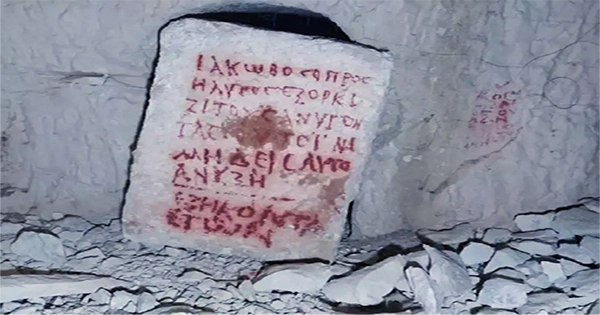If there’s one thing you don’t want to discover in a grave you’ve just dug, it’s a bizarre and sinister inscription warning that anybody who digs it up will be cursed, scrawled in what seems to be blood. But precisely that was found last year in Galilee, a region including northern Israel and southern Lebanon. Archaeologists discovered a 1,800-year-old tomb monument for a Jewish convert called Jacob during work at the UNESCO World Heritage Site Beit She’arim Necropolis, and he was not pleased.
The stone plaque says, “Iokobos [Jacob] the proselyte vows upon himself that those who uncover this grave shall be cursed.” According to Jonathan Price, a professor at Tel Aviv University who translated the tablet, it is a “strange” statement written by Jacob himself in peculiar Greek: According to him, it is how he spoke, according to The Times of Israel. Eight lines on the stone slab are written, with the last line reading: Yaakov Ha’Ger swears to curse anybody who will uncover this grave, thus no one will open it. 60 years of age. The 60, which was added by another person and was written in a different script, is likely a reference to his age.
The earliest tombstone discovered at the location specifically states that the person buried there was a conversion to Judaism. Evgeny Ostrovsky, Israel Antiquities Authority, provided the photo. On June 1, the Israel Antiquities Authority (IAA) and the University of Haifa jointly hosted the Northern Conference, when the finding was announced.
Contrary to appearances, the statement is really painted in red paint, which is somewhat comforting but doesn’t lessen its spookiness of it. One of just two inscriptions unearthed in Beit She’arim in the past 65 years, it is also the only burial marker out of more than 300 uncovered there that explicitly identifies the person buried as a convert. “The inscription dates to the strengthening of Christianity during the Late Roman or Early Byzantine era. The director of the Beit She’arim excavations, Prof. Adi Erlich of the Zinman Institute of Archaeology and the University of Haifa, stated in a statement to IFLScience, “And here we discover proof that there are still people who choose to join the Jewish people.
And because the tomb plaque contains the Greek term “proselyte,” Price continued, “we know that Yaakov Ha’Ger, as his chosen name would have been in Hebrew, was a “complete convert” to Judaism. He explained to The Times of Israel that another category of Jewish adherents at the time, the “God fearer,” would probably not observe all Jewish laws. There are some startlingly fundamental aspects about Jacob that we don’t know, and perhaps we never will, even discovering these intimate details of his life.
According to Price, Bet She’arim is renowned for serving as a Jewish cemetery for people from all over the eastern world. Because of this, it is essentially impossible to determine where he initially came from – “unless we locate his journal, which we won’t,” Price claimed. The craziest thing of all is that we don’t even know where he is right now. The burial monument was located in a cave that had not yet been explored, not near Jacob’s tomb.
Archaeologists haven’t found it, that is. Tomb thieves were very undoubtedly to blame for the marker’s unusual placement, Price said to the Times of Israel, making it extremely unlikely that Jacob’s grave will ever be positively recognized. In other words, keep an eye out for future archaeologists because Jacob’s tomb might be the next one they open that isn’t labelled. And he’ll be furious.















